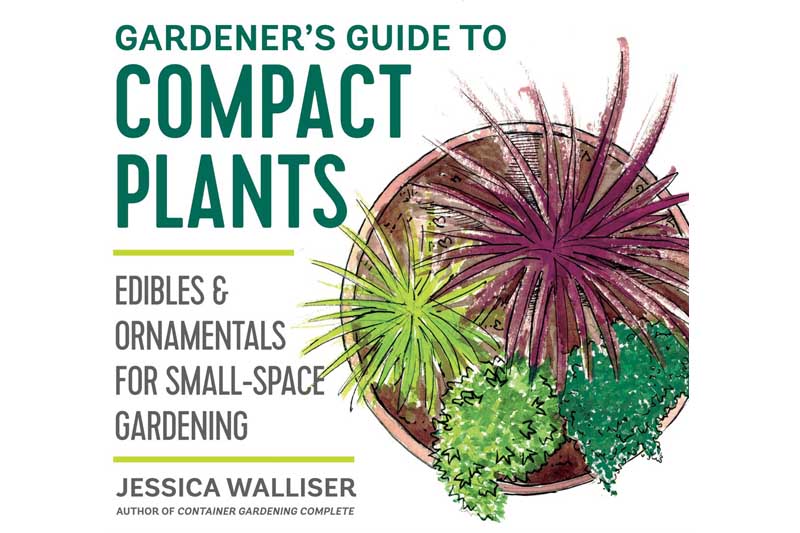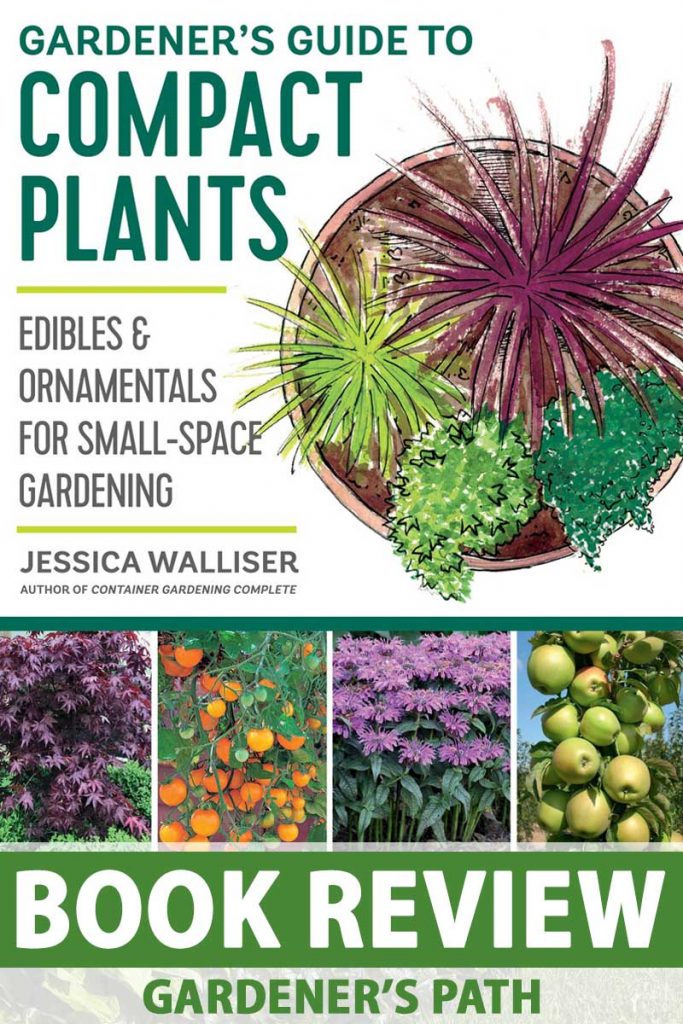Jessica Walliser’s new book, Gardener’s Guide to Compact Plants: Edibles and Ornamentals for Small-Space Gardening, contains all you need to create a lush setting on a restricted scale that’s laden with flowers, fruits, and vegetables.
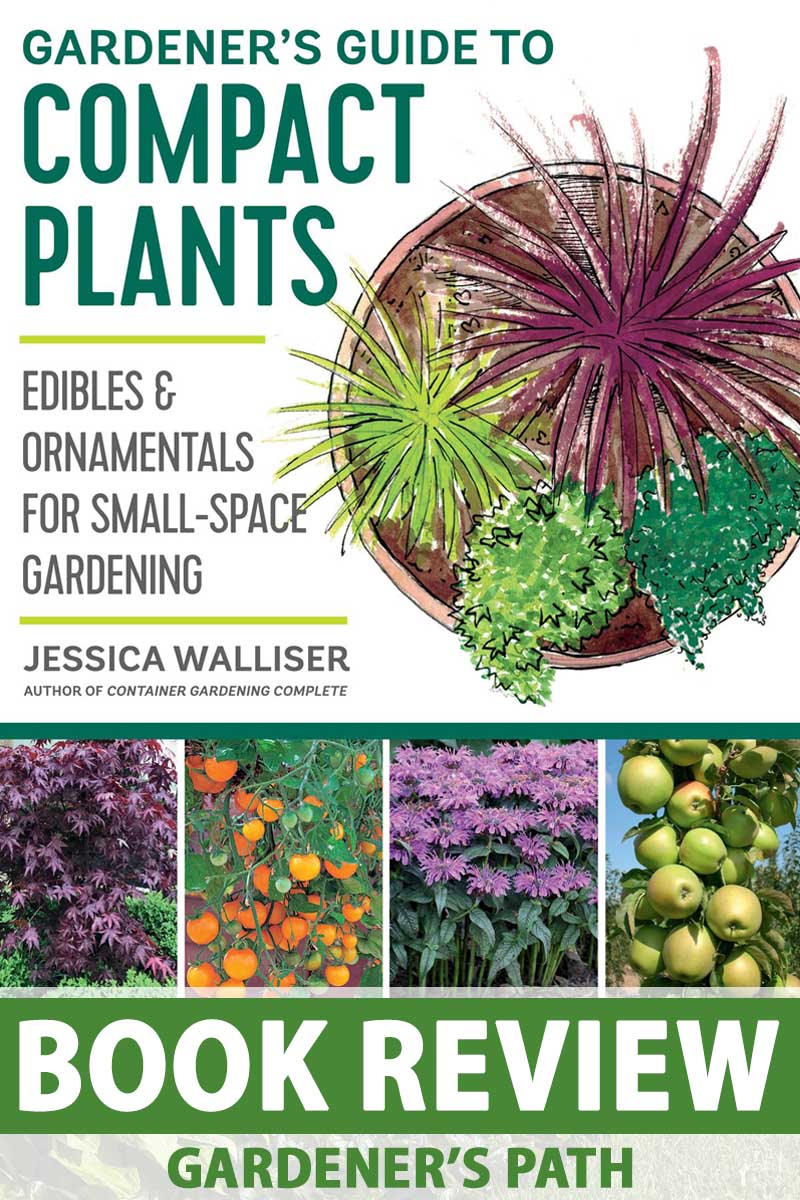
We link to vendors to help you find relevant products. If you buy from one of our links, we may earn a commission.
Whether you have patio pots, a postage-stamp-sized yard, or a community plot, you’ll find ideas you can put to good use in this colorful and informative guide.
Find Gardener’s Guide to Compact Plants: Edibles & Ornamentals for Small-Space Gardening now on Amazon.
Read on for our in-depth review of this exciting new book!
At First Glance
Color photos and drawings adorn the book’s cover, including those of vibrant plum bee balm and columnar apples, which beckon the reader to discover the array within.
My initial flip through the glossy pages revealed an organized arrangement of text and abundant illustrative material. Attractive landscape designs with corresponding plant lists, as well as step-by-step instructions, lured me in for a closer read.
What’s in Store
Gardener’s Guide to Compact Plants is a paperback volume that measures a comfortable 8 x 0.6 x 10 inches and contains 208 pages. At a reasonable weight of only 1.6 pounds, it’s a pleasure to carry out to the yard as needed.
I like that the book is published using paper “from responsible sources,” and that it is also available for Kindle.
The content lineup includes:
- Chapter 1: It’s a Small-Plant World: What Are Compact Plants and Where to Find Them
- Chapter 2: Selecting, Planting, and Maintaining Compact Plants
- Chapter 3: Designing with Compact Plants
- Chapter 4: Compact Plants with Purpose
- Chapter 5: More Compact Plants for the Yard and Landscape: 40 Profiles
- Chapter 6: Compact Plants for the Fruit and Vegetable Garden: 50 Profiles
Additional sections include lists of sources and resources, author background, photo credits, metric conversion charts, and an index.
An Accomplished Author
Jessica Walliser is a renowned horticulturist who received her formal training from Penn State University. She is the co-host of the acclaimed Pittsburgh radio program, “The Organic Gardeners,” and a former contributing editor of Organic Gardening magazine.
You may be familiar with her articles in Fine Gardening and Hobby Farms magazines, as well as four other books, an insect-lovers blog, and the Savvy Gardening website.
And somehow, amidst all of her other projects, Walliser makes time each week to write two columns for the Pittsburgh Tribune-Review, rounding out an impressive body of work aimed at inspiring curiosity and confidence in home gardeners.
Diving In
In her introduction, Walliser discusses how gardening has changed over the years, and how people today generally have smaller spaces for growing and less time to spend tending the garden. It is with this in mind that she has compiled a list of compact varieties with a “petite form and well-behaved growth habit,” for small spaces and container cultivation.
She stresses that dwarf versions of full-size plants offer as much beauty and bounty as their larger counterparts, while requiring far less maintenance. And they, too, create habitat for pollinators, offer solutions to landscape challenges, and provide food for the table.
After an overview of the chapters to come, Walliser concludes by telling readers, “My hope is that Gardener’s Guide to Compact Plants becomes a much-loved co-pilot on your journey toward building the lush and productive small-scale garden of your dreams.”
It’s a Small-Plant World: What Are Compact Plants and Where to Find Them
In chapter one, readers learn the characteristics that qualify a variety for compact status, as well as common and controversial selective breeding techniques horticulturists employ to achieve it.
The author discusses descriptive language a shopper should look for when purchasing small-space species and cultivars, like “bush-type” and “container-friendly.”
Walliser concludes the chapter by saying that while today’s flora is bred for desirable characteristics, she wonders what effect alterations have on the beneficial insects who seek forage and habitat, and may not recognize the new traits.
At her own home, she has native species as well as native and non-native cultivars, and advocates such diversity and the avoidance of pesticides.
Selecting, Planting, and Maintaining Compact Plants
Chapter two begins with a three-step thought process to aid readers in site evaluation, goal setting, and appropriate selection of vegetative material.
It’s followed by detailed instructions on the bedding of perennials; pot-grown and ball and burlap shrubs; and pot-grown, ball and burlap, and bare-root trees.
“The Magic 7 Maintenance Tasks” round out the chapter with these headings: Watering, Pruning, Deadheading, Mulching, Fertilizing, Winter Protection, and Yearly Garden Cleanup. The author stresses that as long as you water, even if you skip the rest, your compact perennials, shrubs, and trees are likely to thrive.
Designing with Compact Plants
Chapter three introduces the idea that even “petite gardens” may be packed full of “color, texture, and year-round interest,” and emphasizes the key elements of scaling down, including proper placement, multiple layers, and accessibility.
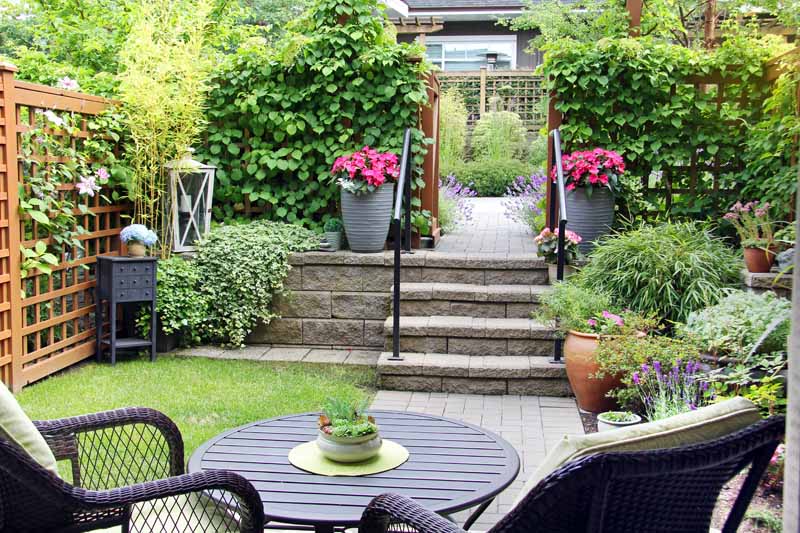
The author shares three tips for healthy vegetation, as well as suggestions for making outdoor spaces inviting with surprises, views, and resting places.
Ten illustrated landscape designs with accompanying plant lists are the highlight of this chapter. Each is the work of a prominent member of the horticultural field in North America, and credentials and contact information are provided for each.
Maybe you’d like to have a “pocket-sized pollinator garden” or a “backdoor cocktail garden?” Arrangements of herbs and edibles, as well as container and raised bed groupings, are included for inspiration or exact replication.
Compact Plants with Purpose
Eight landscape challenges with corresponding small-stature solutions are the topic of chapter four. You’ll find subjects like “A Boring Winter Landscape,” and “A Colorless Garden with No Pizzazz,” followed by short lists of recommended varieties to remedy the situations.
Lush numbered photos correspond to numbered text entries. Each write-up provides important cultural information, such as appropriate growing sites, mature dimensions, growth habits, bloom times, blossom colors, and cold hardiness.
This chapter will help you to think of more than pretty blossoms when you plan and shop. For example, to increase winter interest, consider evergreens and eye-catching berries and bark. And ground covers are a solution that may not only keep that eyesore of a slope from eroding, but help to turn it into a small-scale focal point as well.
More Compact Plants for the Yard and Landscape: 40 Profiles
As its title promises, chapter five contains 40 in-depth descriptions divided into three categories: shrubs, trees, and perennials. The format is concise and makes for easy reference.
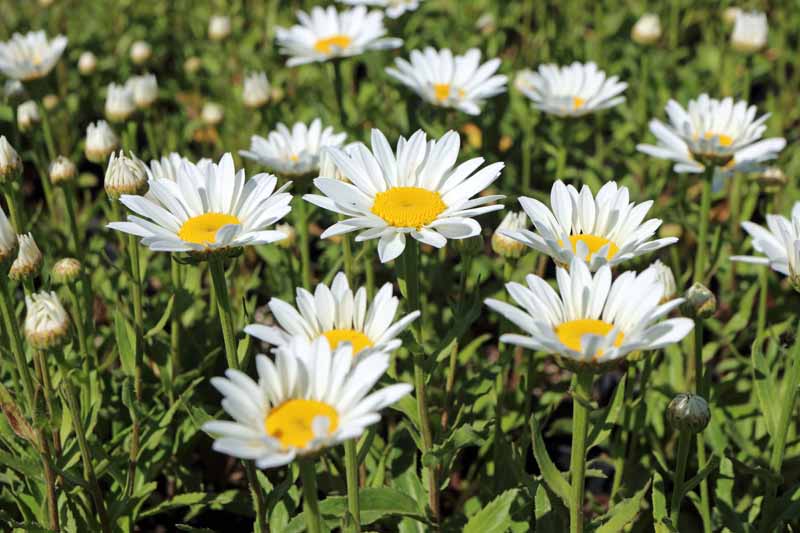
Each listing contains a photo and includes the following:
- Common Name
- Botanical Name
- Plant Type
- Mature Dimensions
- Hardiness
- Ideal Sun Conditions
- Physical Appearance
- Care Requirements
- Extra Info
The “Extra Info” section may include items such as suitability for a particular design style, exceptional fall foliage, noteworthy disease resistance, tolerance of clay soil, or poor salt tolerance.
Note that listings are by cultivar name and are not alphabetized.
Walliser stresses that cultivation success may vary by region and care received.
Compact Plants for the Fruit and Vegetable Garden: 50 Profiles
As she introduces chapter six, the author shares that the varieties listed have worked for her, and “… are not just cutie-pie plants that are fun to look at; they’re also resistant to common plant pathogens, easy to grow, high yielding, and delicious!”
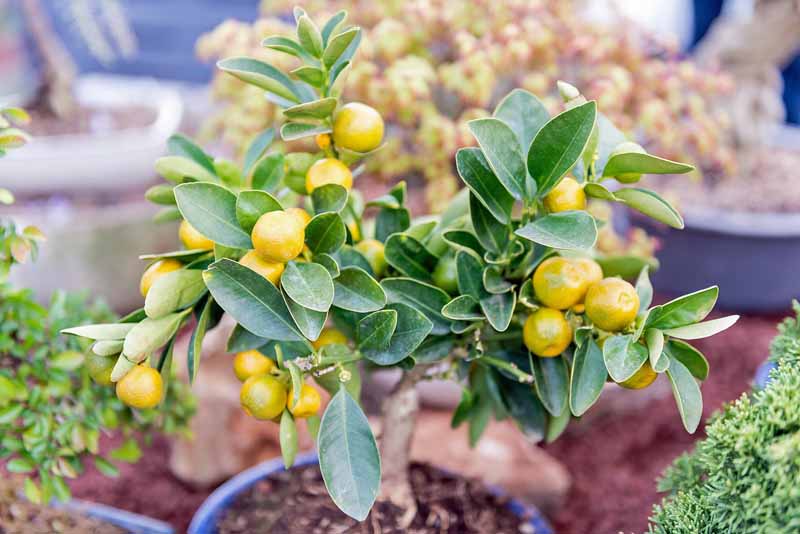
She shares tips for sun exposure and watering before launching into detailed descriptions of 50 edibles. Each entry has a photo and the following sections:
Common Name, Botanical Name, Mature Dimensions, Physical Appearance, Planting Tips, Care Requirements, and Harvest Time.
As with the previous chapter, listings are by cultivar name, and are not alphabetized.
Walliser notes that there is an abundance of “pint-sized” edibles available today, and that breeders continue to develop disease-resistant varieties with exceptional flavor and bountiful harvests.
Following the six chapters is the “Source List,” which lists the contact information for reputable horticultural retailers and wholesalers who may be contacted to locate their products for purchase.
A well-curated list of horticultural books for further reading follows.
Additional Sections
“About the Author” and “Photo Credits” come next, and they’re fun reads. I like to see an author’s friendly face and get a glimpse into his or her professional portfolio and home life. Photos for this book were widely sourced, and efficiently complement the text.
“Metric Conversions” has handy reference charts for quickly converting centimeters to inches and Celsius to Fahrenheit, to make using non-US-sourced seeds and materials a breeze.
The index contains botanical names in italics, and cultivar and common names in standard font.
Observations
There are some items I’d like to mention regarding cross-referencing and photographs.
If you look up ‘French Mascotte’, you’ll find two pages for reference. First is page 72, where it appears in the recommendations for the “Kitchen garden with compact edible plants.” Second is page 162, where you’ll see a detailed description.
However, if you simply look up “bush bean,” you’ll be directed only to page 162.
Similarly, you may turn to page 162 and read all about this cultivar, but on that page, there’s no reference to page 72 and its role in the kitchen scheme.
In addition, while the photos are gorgeous, the flora shown is not all identified. For example, on pages 8 and 12, there’s a robust yellow-flowered, red-berried bush that appears to be a Hypericum androsaemum (aka shrubby St. John’s wort). My neighbor has one, and I was eager to learn about it, but there’s no caption or description.
But these discrepancies are few, and they don’t detract from the information provided.
Overall, this is an excellent resource that I know I’ll refer to often.
Are you ready to get started? Do you know what plants you’re going to buy? Which configuration best suits your needs? Let the Gardener’s Guide to Compact Plants guide your efforts toward success!
If you enjoyed reading this article, you’re sure to like:
- Best Ways to Garden in Small Spaces
- How to Grow Vegetables in Containers
- Cultivating Harmony with Nancy Lawson’s The Humane Gardener
- On Constructing Urban Gardens with Matt James
- The Best 11 Vegetables to Grow in Pots and Containers
Book cover image courtesy of Cool Springs Press. Used with permission by Ask the Experts, LLC. All rights reserved by all parties. A copy of this book was provided by the publisher or author for review. Other images: Shutterstock.
